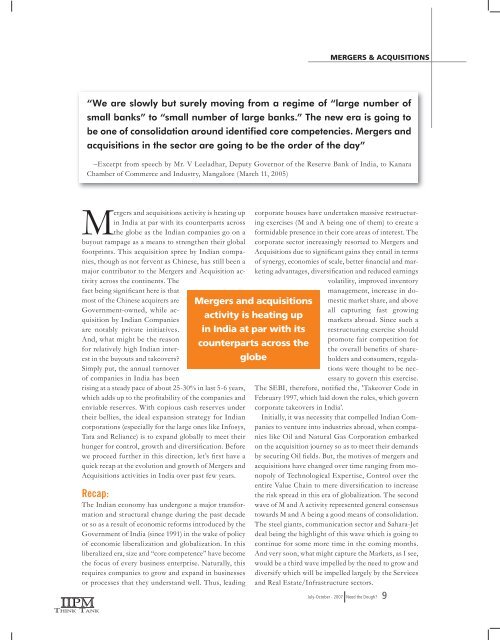india going global.indd - The IIPM Think Tank
india going global.indd - The IIPM Think Tank
india going global.indd - The IIPM Think Tank
You also want an ePaper? Increase the reach of your titles
YUMPU automatically turns print PDFs into web optimized ePapers that Google loves.
MERGERS & ACQUISITIONS<br />
“We are slowly but surely moving from a regime of “large number of<br />
small banks” to “small number of large banks.” <strong>The</strong> new era is <strong>going</strong> to<br />
be one of consolidation around identified core competencies. Mergers and<br />
acquisitions in the sector are <strong>going</strong> to be the order of the day”<br />
–Excerpt from speech by Mr. V Leeladhar, Deputy Governor of the Reserve Bank of India, to Kanara<br />
Chamber of Commerce and Industry, Mangalore (March 11, 2005)<br />
Mergers and acquisitions activity is heating up<br />
in India at par with its counterparts across<br />
the globe as the Indian companies go on a<br />
buyout rampage as a means to strengthen their <strong>global</strong><br />
footprints. This acquisition spree by Indian companies,<br />
though as not fervent as Chinese, has still been a<br />
major contributor to the Mergers and Acquisition activity<br />
across the continents. <strong>The</strong><br />
fact being significant here is that<br />
most of the Chinese acquirers are<br />
Government-owned, while acquisition<br />
by Indian Companies<br />
are notably private initiatives.<br />
And, what might be the reason<br />
for relatively high Indian interest<br />
in the buyouts and takeovers<br />
Simply put, the annual turnover<br />
of companies in India has been<br />
rising at a steady pace of about 25-30% in last 5-6 years,<br />
which adds up to the profitability of the companies and<br />
enviable reserves. With copious cash reserves under<br />
their bellies, the ideal expansion strategy for Indian<br />
corporations (especially for the large ones like Infosys,<br />
Tata and Reliance) is to expand <strong>global</strong>ly to meet their<br />
hunger for control, growth and diversification. Before<br />
we proceed further in this direction, let’s fi rst have a<br />
quick recap at the evolution and growth of Mergers and<br />
Acquisitions activities in India over past few years.<br />
Recap:<br />
<strong>The</strong> Indian economy has undergone a major transformation<br />
and structural change during the past decade<br />
or so as a result of economic reforms introduced by the<br />
Government of India (since 1991) in the wake of policy<br />
of economic liberalization and <strong>global</strong>ization. In this<br />
liberalized era, size and “core competence” have become<br />
the focus of every business enterprise. Naturally, this<br />
requires companies to grow and expand in businesses<br />
or processes that they understand well. Thus, leading<br />
corporate houses have undertaken massive restructuring<br />
exercises (M and A being one of them) to create a<br />
formidable presence in their core areas of interest. <strong>The</strong><br />
corporate sector increasingly resorted to Mergers and<br />
Acquisitions due to significant gains they entail in terms<br />
of synergy, economies of scale, better fi nancial and marketing<br />
advantages, diversification and reduced earnings<br />
volatility, improved inventory<br />
management, increase in domestic<br />
market share, and above<br />
all capturing fast growing<br />
markets abroad. Since such a<br />
restructuring exercise should<br />
promote fair competition for<br />
the overall benefits of shareholders<br />
and consumers, regulations<br />
were thought to be necessary<br />
to govern this exercise.<br />
<strong>The</strong> SEBI, therefore, notified the, ’Takeover Code in<br />
February 1997, which laid down the rules, which govern<br />
corporate takeovers in India’.<br />
Initially, it was necessity that compelled Indian Companies<br />
to venture into industries abroad, when companies<br />
like Oil and Natural Gas Corporation embarked<br />
on the acquisition journey so as to meet their demands<br />
by securing Oil fields. But, the motives of mergers and<br />
acquisitions have changed over time ranging from monopoly<br />
of Technological Expertise, Control over the<br />
entire Value Chain to mere diversification to increase<br />
the risk spread in this era of <strong>global</strong>ization. <strong>The</strong> second<br />
wave of M and A activity represented general consensus<br />
towards M and A being a good means of consolidation.<br />
<strong>The</strong> steel giants, communication sector and Sahara-Jet<br />
deal being the highlight of this wave which is <strong>going</strong> to<br />
continue for some more time in the coming months.<br />
And very soon, what might capture the Markets, as I see,<br />
would be a third wave impelled by the need to grow and<br />
diversify which will be impelled largely by the Services<br />
and Real Estate/Infrastructure sectors.<br />
Mergers and acquisitions<br />
activity is heating up<br />
in India at par with its<br />
counterparts across the<br />
globe<br />
July-October - 2007 Need the Dough<br />
9





![[Feb 2008, Volume V Annual Issue] Pdf File size - The IIPM Think Tank](https://img.yumpu.com/43961117/1/190x245/feb-2008-volume-v-annual-issue-pdf-file-size-the-iipm-think-tank.jpg?quality=85)
![[June 2008, Volume V Quarterly Issue] Pdf File size - The IIPM Think ...](https://img.yumpu.com/41693247/1/190x245/june-2008-volume-v-quarterly-issue-pdf-file-size-the-iipm-think-.jpg?quality=85)







![[Dec 2007, Volume 4 Quarterly Issue] Pdf File size - The IIPM Think ...](https://img.yumpu.com/29766298/1/190x245/dec-2007-volume-4-quarterly-issue-pdf-file-size-the-iipm-think-.jpg?quality=85)

![[Volume VI | Quarterly Issue: 31st May 2009] Pdf File size](https://img.yumpu.com/27796051/1/190x245/volume-vi-quarterly-issue-31st-may-2009-pdf-file-size.jpg?quality=85)